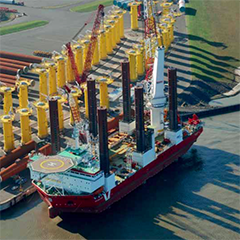nke Onnen-Lübben, MD, Seaports of Niedersachsen GmbH talks to PES about the changes in legislation in Germany to wind energy and consequenses to the ports……
PES: Welcome back to the magazine. Would you like to begin by explaining a little about the background of your organization and how you currently serve the wind industry?
Inke Onnen-Lübben: Thanks for the opportunity to speak about the situation in our ports with regards to wind energy. The Seaports of Niedersachsen acts as the marketing organization for the nine seaports in the federal state of Niedersachsen in Northern Germany. Niedersachsen is the no.1 state in Germany for wind energy. We have about 8,600 MW of installed onshore wind energy capacity in Niedersachsen and 1,500 MW of the total 3,000 MW installed offshore wind capacity along the German Bight that is connected to the grid via Niedersachsen. Also some of the world’s leading wind energy manufacturers are based in our federal state.
So it goes without saying that the seaports in Niedersachsen are also active in the field of wind energy logistics. Acting as the marketing organization we help our port operating companies to publicise the logistics services on offer to the wind energy industry. These services mainly comprise the storage and handling of onshore and offshore wind energy components as well as – in case of the offshore business – supply services for offshore wind parks and the converter platforms by vessel and helicopter. Our seaports have been in the onshore business for almost 20 years now and gained great experience in the handling of sensitive components. ENERCON, as one of the most important onshore manufacturers, for example, has chosen the port of Emden as one of its hubs for the worldwide distribution of their products.
The port of Brake also handles onshore wind energy components for several manufacturers and offers various value-added services such as spare part management for their customers. For several years now our seaports have been responsible for shipments of offshore wind energy components. Cuxhaven is one of our most active ports in this area. The offshore business creates different demands on a port terminal than the onshore industry. Most components are extremely heavy so specially paved handling and storage areas are needed for these shipments along with the heavy load handling equipment. The ports also have to provide berths designed for jack-up vessels where these specialized vessels can come to at any time. Cuxhaven, Emden, Nordenham and Wilhelmshaven all have these infra- and superstructures.


























